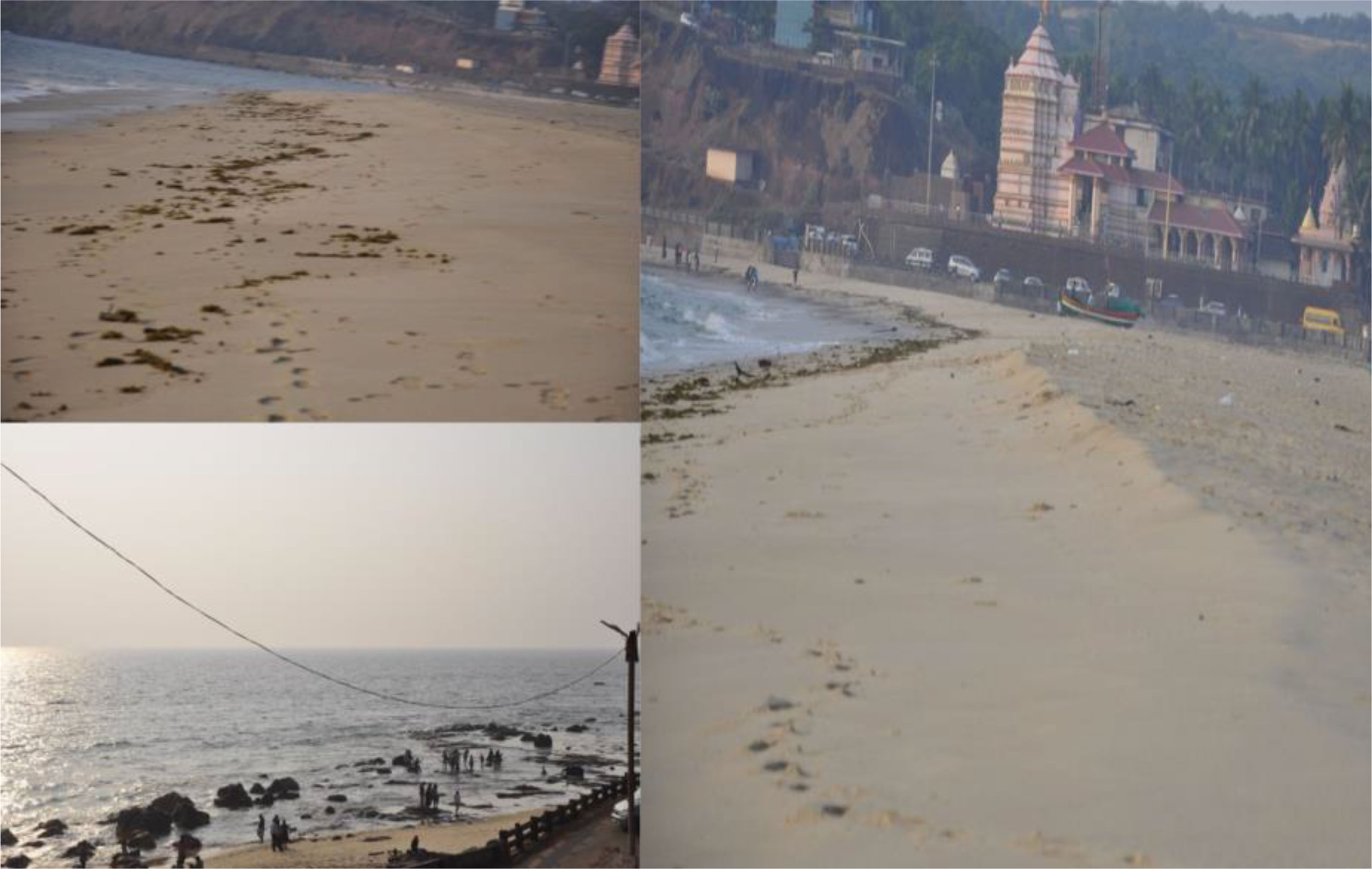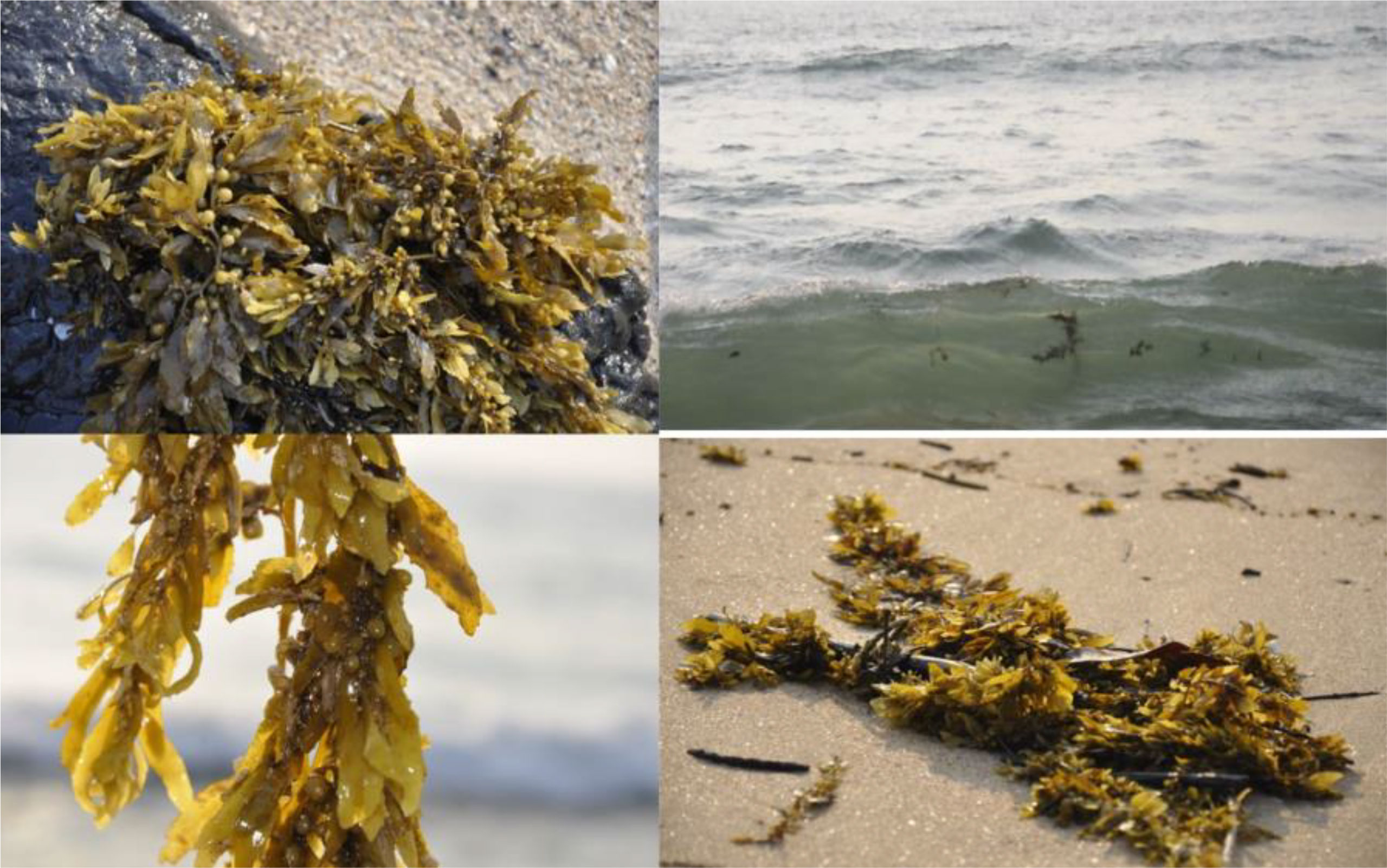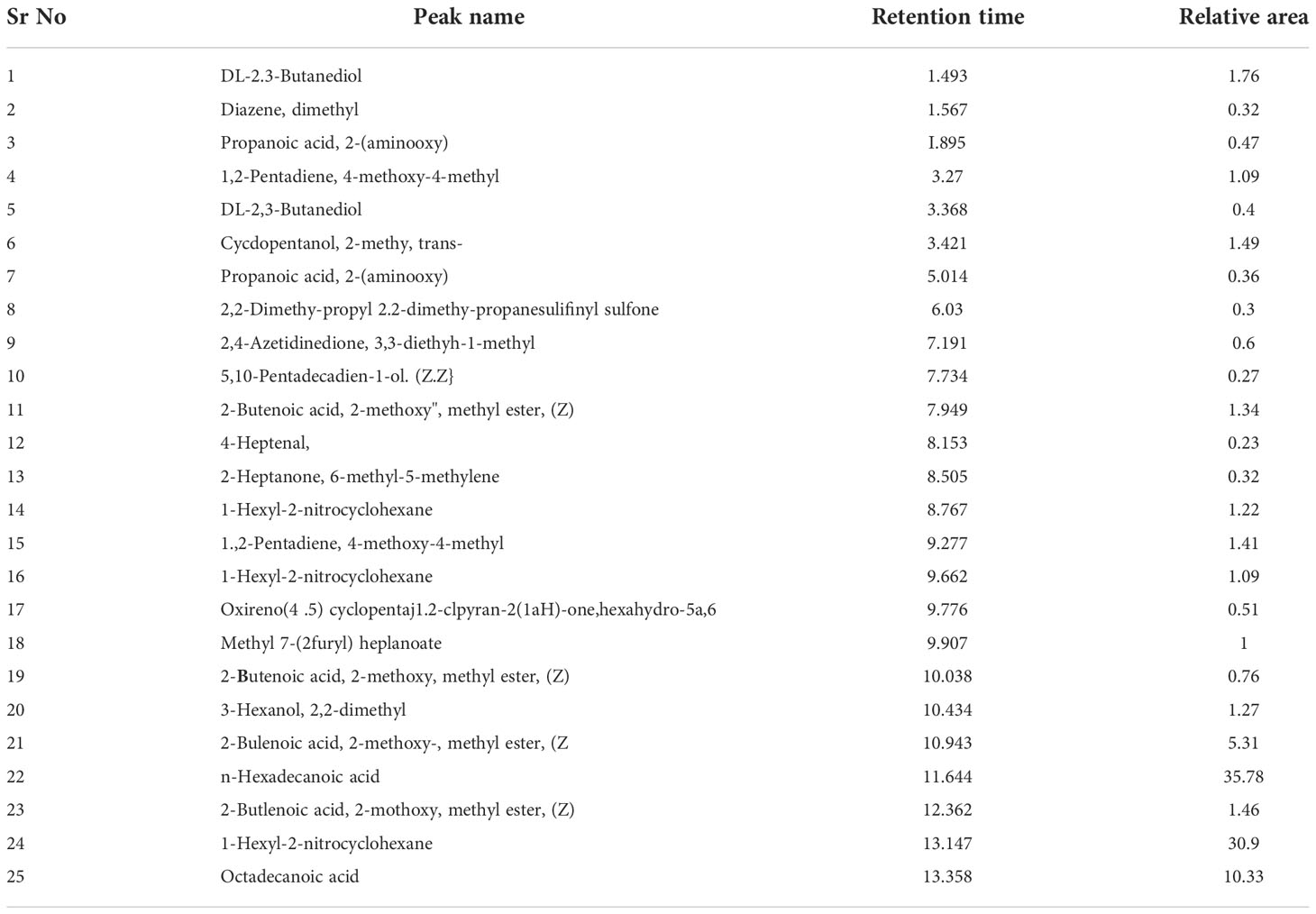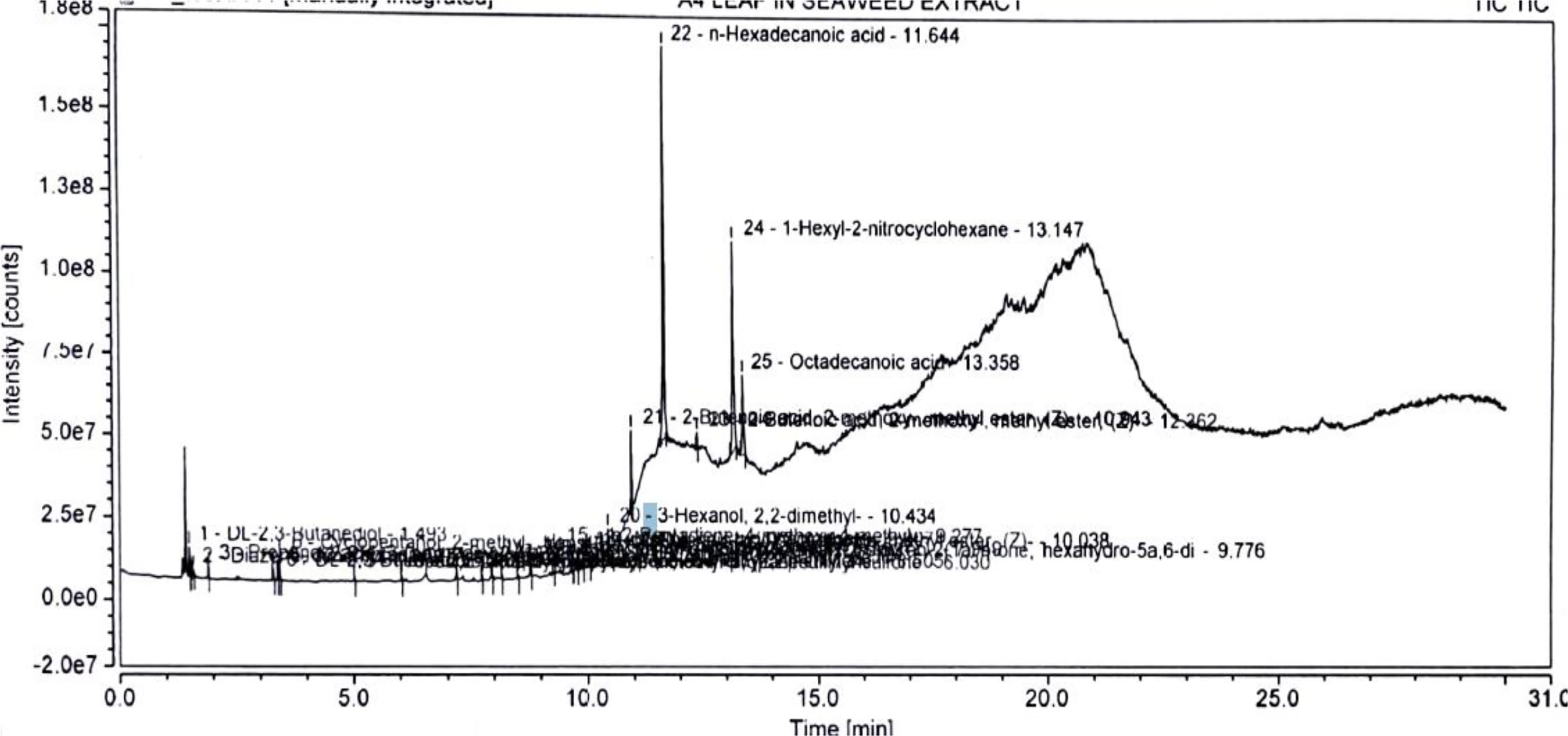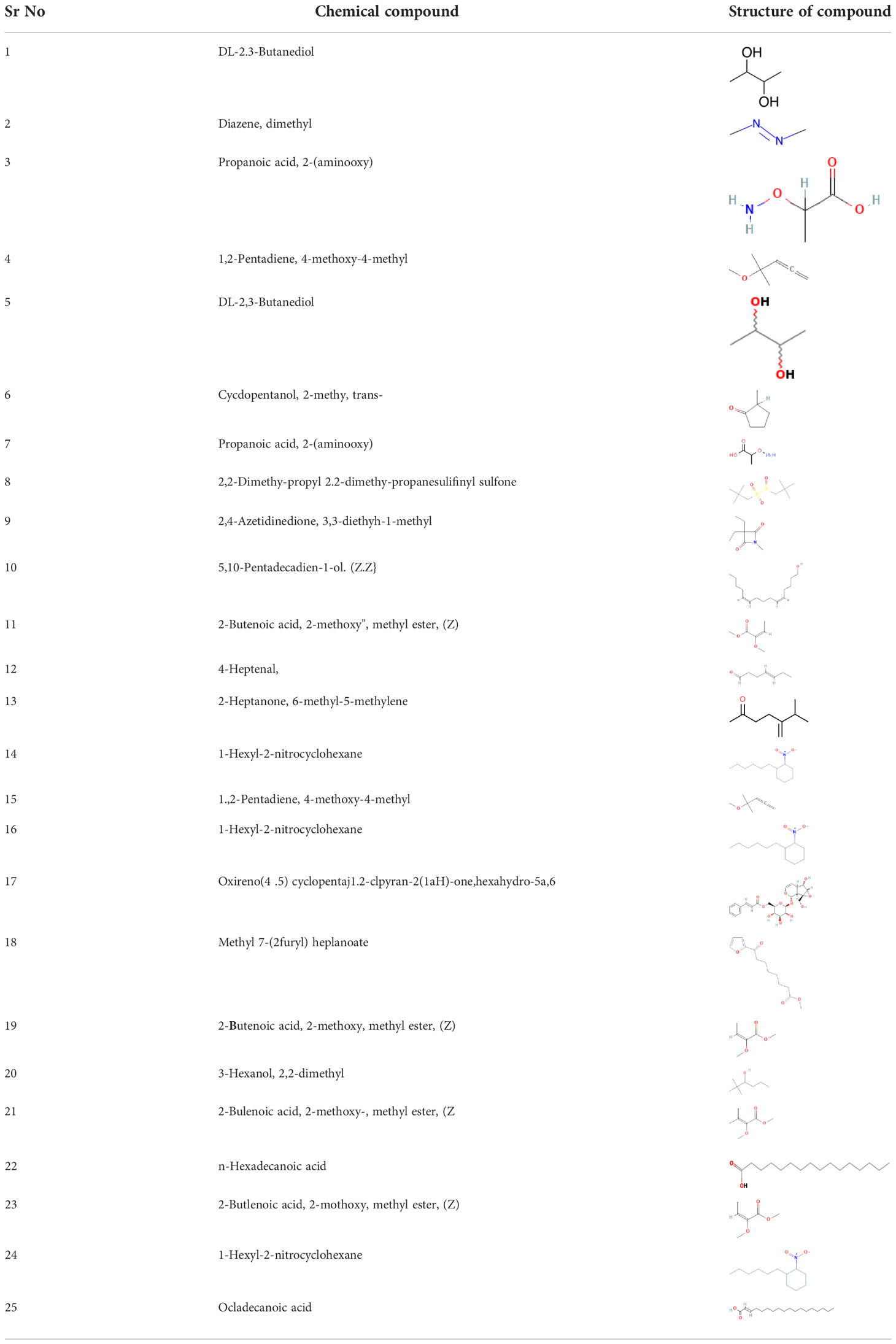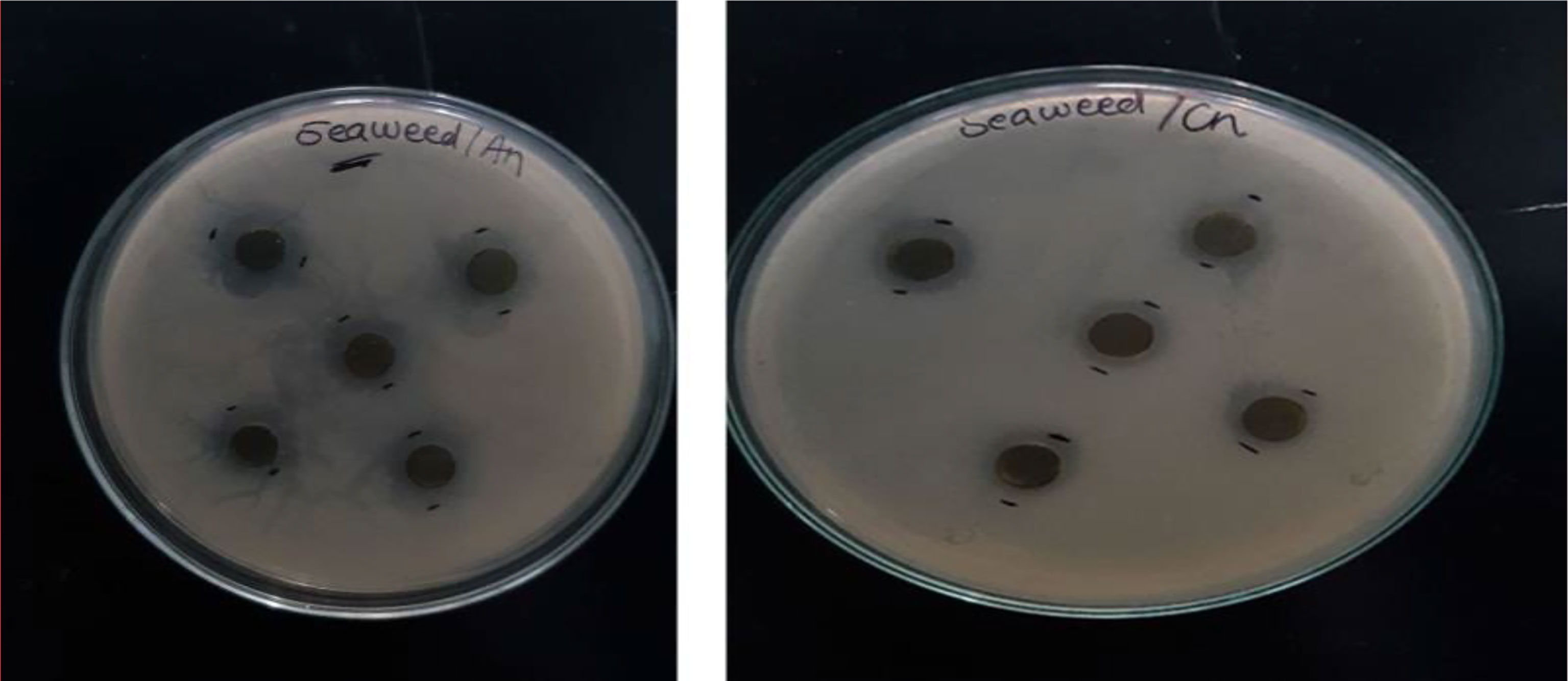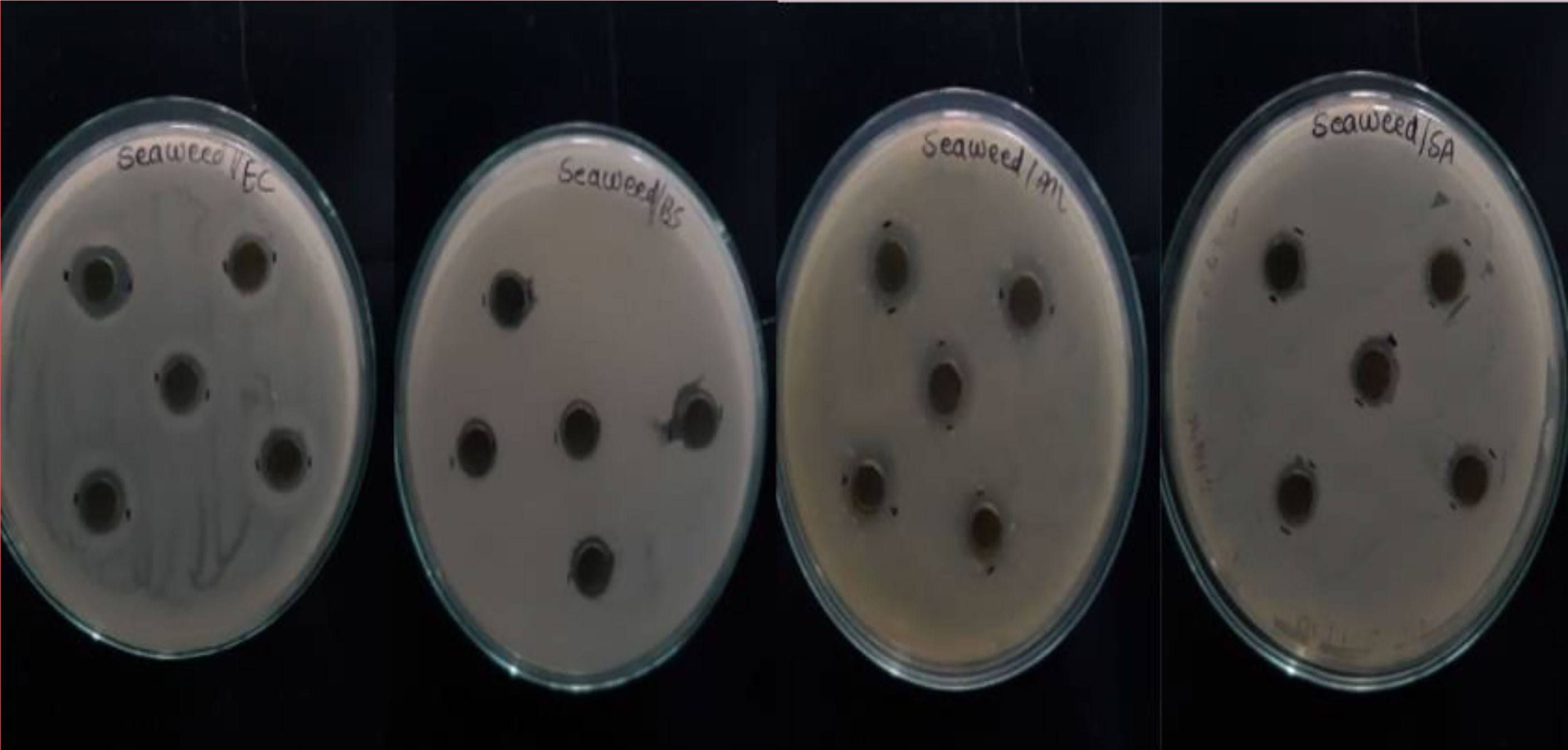- 1Department of Biotechnology, Persian Gulf Research Institute, Persian Gulf University, Bushehr, Iran
- 2Department of Botany, Yashavantrao Chavan Institute of Science, Satara, Maharashtra, India
- 3Department of Agriculture Science, Faculty of Agro-Based Industry, Universiti Malaysia Kelantan, Kelantan, Malaysia
- 4Faculty of Nano and Bio Science and Technology, Persian Gulf University, Bushehr, Iran
- 5Faculty of Data Science and Information Technology, INTI International University, Nilai, Malaysia
- 6Department of Orthopaedics, School of Medical Sciences, Universiti Sains Malaysia, Ku-bang Kerian, Kelantan, Malaysia
- 7Faculty of Science and Marine Environment, Universiti Malaysia Terengganu, Kuala Nerus, Terengganu, Malaysia
- 8Institute of Tropical Biodiversity and Sustainable Development, Universiti Malaysia Terengganu, Kuala Nerus, Terengganu, Malaysia
A promising plant group that is important in medicine is the seaweed. In this investigation, we have focused on the pharmacological prospects of brown algae (Sargassum sp). Nutraceuticals refer to products that may combine pharmacological and nutrition. We have collected the plant material close to Kunkeeshwar in Sindhudurg, Maharashtra’s western coast. We focused on the Physicochemical Attributes of Sargassum sp., and the study found that the ash value (41 ± 0.67), moisture content (1.33 ± 0.038), alcohol-soluble extractive value (1.5 ± 0.030), moisture content (1.33 ± 0.038), and total cash value (41 ± 0.67) are all stated in (%).The GCMS findings, which demonstrate that a total of 25 chemicals were discovered in the aqueous extract of Sargassum sp., also represent their nutritional profile. All of these substances have chromatograms that can be observed.1-Hexyl-2-nitrocyclohexane is the substance with the second-largest retention duration and relative areas, followed by n-hexadanoic acid. The presence of ocladecanoic acid was later determined. The explanation for how the activity is concentration-dependent is pharmacological activity, particularly antioxidant activity as shown by the DPPH assay.2μg/mL is -1545.4 ± 0.05. as a minimum. and at (32 g/mL is 7.67 ± 0.05) is the highest. The antifungal activity of Candida albicans (12.8 mm) and Aspergillus niger (14.4 mm) both exhibit zone inhibition when tested against two distinct pathogen however, the antibacterial activity of three different bacteria demonstrates that Staphylococcus aureus (12 mm), Bacillus subtilis (10 mm), Proteus mirabilis (12.8 mm), and Escherichia. coli are all zone inhibited (13mm). Brown algae offer the greatest potential for human health nutrition, while pharmacological analysis is helpful for therapeutic application, according to the overall analysis.
Introduction
Seaweed is a type of aquatic plant that grows mostly in a marine environment. According to their pigmentation, often known as seaweeds, can be divided into red (Rhodophyta), brown (Phaeophyta), and green seaweeds (Chlorophyta) (Dawczynski et al., 2007). Algae have rich mineral, carbohydrate, and protein contents and are rapidly expanding organisms. The majority of these, comprising 60–70% of the total algal content, are carbohydrates in the form of cellulose and starch. Prior studies have revealed that bioactive substances originating from algae, such as polysaccharides, phlorotannins, minerals, and omega-3 fatty acids, function as prebiotics and may also benefit users in terms of antibacterial, antioxidant, and immunomodulatory properties (Choi et al., 2020a). The country reported that the marine algae industry in Korea has been thriving for a while. Finding novel bioactive compounds from marine organisms for usage in bioindustries such as bioenergy, food, medicines, and cosmetics is exciting. Recent animal feed research has focused on creating substitutes for conventional feed components to minimize environmental and financial concerns. Algae are a desirable feed source with several potential uses outside the realm of human eating (Choi et al., 2020b). Sargassum sp. has been reported to have a nutritional composition of 89% dry matter, 8% crude protein, 31% ash, 2% ether extract, and 39% carbohydrates (Casas-Valdez et al., 2006). Seaweeds can grow in estuaries, oceans, and shallow waters. It is a sort of primitive plant that can appear in large and small shapes and is categorized as macroalgae and microalgae. Some plants can grow up to 30 meters in length, although most are a variety of sizes. Seaweed develops by adhering to the substrate and growing on the beach, intertidal zone, and ocean surface. Since ancient times, seaweed has been consumed as food in many Asian nations, and it is also frequently used as a source of biochemicals for usage in food, medicine, and cosmetics. It has a wide variety of aquatic plants. Based on their separate classifications as Chlorophyte, Rhodophyta, Pheophyta, and Cyanophyta, green algae, red algae, brown algae, and blue-green algae on their photosynthetic pigment (Barwant and Karande, 2021). One report has documented Sargassum meals were analyzed using proximate composition, and the nutritional value of sargassum meals may be determined. Crude protein and fat concentrations in seaweed meals were 10.28% and 0.418%, respectively. Ash came in second, making up 32.46% of the seaweed, behind carbohydrates, which made up 46.61%. Crude fiber’s percentage is 10.25% (Serrano Jr et al., 2015). Since ancient times, seaweed has been consumed as food in many Asian nations, and it is also frequently used as a source of biochemicals for usage in food, medicine, and cosmetics. It has a wide variety of aquatic plants. Based on their separate classifications as Chlorophyte, Rhodophyta, Pheophyta, and Cyanophyta, green algae, red algae, brown algae, and blue-green algae on their photosynthetic pigment (Barwant and Karande, 2021). The significance of marine species as sources of novel bioactive compounds is rapidly growing. Marine species are plentiful suppliers of structurally diverse bioactive chemicals. S. fulvellum is a brown edible seaweed that is rich in natural bioactive compounds as well as nutrients (carbohydrates, unsaturated fatty acids, protein composition, vitamins, and minerals) (phlorotannins, grasshopper ketones, and polysaccharides). Seaweeds are used in East Asian nations including China, Korea, and Japan as both curative ingredients and nutritious foods. In recent years, seaweeds have received a lot of attention as potential sources of functional metabolites. Interest has been raised by the physiologically active ingredients’ expanding potential as functional ingredients in the pharmaceutical, food, and cosmetic industries. According to a source, seaweed is thought to be edible and includes considerable amounts of carbohydrates (30–60%), including cellulose, fucoidan, laminaran, alginic acid, protein (15.8%), ash (27.5%), and relatively little fat (5%) (Liu et al., 2020). Seaweeds are regarded as nutrient-dense foods since they are low in calories and high in protein, vitamins, minerals, and bioactive compounds. The nutritional composition of seaweeds is influenced by a number of variables, including seaweed species, habitat, maturity stage, season, temperature, and sampling circumstances. There have been comparatively few studies on seaweed’s nutritional benefits in India, despite the fact that numerous studies on the subject have been done. Additionally, fresh seaweeds have been the subject of the majority of studies on seaweed nutrients, with dried seaweeds receiving very little attention (Debbarma et al., 2016). In the Phaeophyceae family, Sargassum sp. is a brown seaweed genus that is largely unexploited and grows unchecked in enormous quantities virtually everywhere on Earth. In tropical and subtropical waters, it grows close to beaches with a rocky substrate, rolling stones, and pebbles (Serrano Jr et al., 2015). It has been reported 150 of the 250 macroalgal species that have been economically exploited globally are utilized as human food. Various brown algal preparations have been used in traditional Asian medicine (Anastyuk et al., 2017).
Phytochemicals, or non-nutritive plant compounds with disease-prevention or defense mechanisms, are well-known. Numerous physiological, biochemical, and enzymatic procedures that are not dependent on dietary intake of bioactive components allow the human body to combat oxidative stress. There isn’t much proof, according to earlier studies, that consuming more dietary antioxidants enhances their bioavailability in the body’s physiological system. Seaweeds are rich in important bioactive chemicals, including protein, fiber, vitamins, polyunsaturated fatty acids, macro and trace elements, and others. It’s crucial to note that phytochemicals may have additional physiological advantages even though their value in reducing oxidative stress is controversial. Previous studies using cell culture and animal models have shown that seaweed phytochemicals may inhibit the development of cancer (Ranjani Devi et al., 2018). Seaweeds have long been a staple of eastern diets, especially in Japan, China, and Korea, due to their availability of vital elements. Worldwide, 65 percent of seaweeds that are commercially grown are consumed for human sustenance. In Japan, seaweeds have been used to make a wide range of products, including jam, cheese, wine, tea, soups, and noodles. Agar, algin, and carrageenan, which are utilized as a gelling, stabilizing, and thickening agent in a number of industrial applications including medicines, cosmetics, and food, are also primarily derived from seaweeds (Debbarma et al., 2016).
In addition to having a healthy balance of essential amino acids, Sargassum is rich in dietary fiber, brown algal starch, minerals, vitamins, and good high-unsaturated fatty acids. Chemical scores of essential amino acids are greater than those of Laminaria and Porphyra. Therefore, sargassum may be a viable raw material for dietary supplements and marine drugs (Laihao et al., 1997). As a result, we have reviewed in depth the nutritional profile of Sargassum sp., including its biochemical, phytochemical, and biological activities.
Phlorotannins are secondary metabolites produced by brown seaweeds with antiviral, antibacterial, antifungal, and larvicidal activities. Phlorotannins’ structures are formed by dibenzodioxin, ether and phenyl, ether, or phenyl linkages. The polymerization of phlorotannins is used to classify and characterize (Negara et al., 2021). Alginates of four locally harvested Ghanaian brown seaweeds from the Sargassum and Padina genus were assessed for their rheological and chemical characteristics. The seaweeds contained 16–30% by weight of alginate assessed as the sum of d-mannuronic acid (M) and l-guluronic acid (G) (Rhein-Knudsen et al., 2017). This study was carried out to study the effects of selenylation on physicochemical and biological properties of polysaccharide (SPP) extracted from Sargassumpallidum (Xiao et al., 2019). Sargassumcristaefolium and Sargassumcrassifoliumhada water content of 89.34 percent and 88.56 percent, respectively. Species, harvest age, can influence water content differences in Sargassum, and environmental circumstances Sargassumcrassifolium has a high ash content (41.52) and in Sargassumcristaefolium (41.28) (Dewinta et al., 2020). These antibacterial chemicals were made up of alkane, alkene, alkanol, and carboxylic acids. Antibacterial chemicals are thought to synergistically reduce bacterial growth (Firdaus et al., 2019). Another report on the Antifungal activity of 96% ethanol extracts of Sargassumcrassifolium and Sargassumpolycystum against Candida albicans growth revealed a wide range of inhibitory diameters. The inhibitory areas of Sargassumcrassifolium and Sargassumpolycystum extracts are 20.3 mm and 20 mm in diameter, respectively (Yulianti, 2018). Sargassumfucoidan is a kind of sulfatedheteropolysaccharide with a variety of biological activities. The aim of this study was to investigate the extraction, purification, physicochemical characterization and in vitro antithrombotic activity of fucoidan from Sargassumhenslowianum (Lin et al., 2022).
Material and methods
Study region
Kunkeshwar and Malvan are two gathering sites for sargassum (plant material). Kunkeshwar is situated in the Sindhudurg district of Maharashtra, on the western coast of India. In addition, the area is known for its beautiful beach, rich vegetation, and crystal-clear water. A well-known pilgrimage site known for the Kunkeshwar yatra and the Mahashivratri festival is the Kunkeshwar temple (fair). It is situated in the Konkan region, south of the Devgad fort. The turquoise Arabian Sea is on one side, and the Sahyadri mountains with their green summits are on the other. 63 kilometres to the northwest of Sindhudurg, 137 to Kolhapur, and 420 to Mumbai separate it. The Konkan belt experiences considerable rainfall (ranging from 2500 to 4500 mm), and the temperature is consistently humid and warm. Rainfall is the most frequent weather pattern in the area. The temperature can rise beyond 30 degrees Celsius during this period (Geographic details of collecting site; Figure 1 Plate 1 show Kunkeshwar and Malvan). We routinely visited the collection site, where we saw an abundance of Sargassum sp. We have gathered sargassum sp. from this collecting site as seen in Figure 2. Authentic books and floras like can help in identification (Srinivasan, 1969).
Identification of seaweed
The Sargassum spp identification was done by observing its morphological characterization and available literature references and by using herbarium comparative study Because of the variety in form, it can be challenging to distinguish between different Sargassum species. Fortunately, based on a few reoccurring traits, the plants can be identified as belonging to the genus. The prominent stem-like axis and distinctive foliar blades that define the genus are its defining traits. These long, oval-shaped blades might have striated or smooth edges. In addition, there are many of tiny air bladders that resemble berries. The plants’ hues, which range from yellow-brown to a deep, rich chocolate, are also pretty stable.
Preparation of extract
Seaweed samples were hand-picked and then rinsed in seawater to remove foreign particles, grit, and epiphytes. It was then taken to the laboratory and properly cleaned using tap water. The seaweeds were then spread out on blotting paper to absorb any extra moisture. The samples were dried and ground into a fine powder, which was then utilized to generate extracts in three different mediums: alcohol, aqueous, and acidic, which were subsequently employed in the phytochemical investigation. Analysis of biochemical parameters Antioxidant and biological activity and GC-MS.
Physicochemical analysis
The total plant material’s physicochemical composition was determined using recognized methods and WHO criteria. During the physicochemical analysis, various properties were calculated, including ash values, extractive values, and loss on drying. When analyzing crude pharmaceuticals, it’s crucial to consider their extractive values, especially if it’s challenging to identify the constituents in the drug using standard techniques. These values also represent the substance’s worth in a crude medication (Pharmacopoeia, 1996). The ash content was determined using the gravimetric method, which involved burning the sample in a furnace at 600°C until it turned ash. The ash content was calculated as a percentage of ash weight to dry sample weight. Ash values determine the grade and purity of crude drugs. It denotes the presence of carbonate, oxalate, and silicate contaminants. The amount of inorganic components in pharmaceuticals is estimated using water-soluble ash. Silica makes up the majority of acid-insoluble ash, which is a sign of contamination with earthy material. Medication moisture content should be kept to a minimum to avoid the growth of bacteria, yeast, or fungi while being stored. By estimating it, the amount of the extraction value is determined. utilizing a specific solvent, active substances were extracted from a specified volume of plant material (Garg et al., 2011; Chanda, 2014).
GC-MS analysis of Sargassum aqueous extract
GC-MS test was carried out by GC-17A Agilent 5890 series II Plus, capillary column type HP 5-MS, GC-MS type detector Agilent Technologies 5975C inert MSD with Triple-Axis. The sample flowed with helium gas with a flow rate of 0.7 mL/min, where the injector temperature was 295o C, and the oven temperature was set to 70o C for 2 minutes and increased by 10o C per minute to 295o C (Firdaus et al., 2019).
Antioxidant activity
DPPH free radical scavenging activity
The radical scavenging activity of the synthesized compounds against stable free radical 2.2- diphenyl-2- picrylhydrazyl hydrate (DPPH, Sigma-Aldrich Chemie, Steinheim, Germany) was determined to be a spectrophotometric ally. It is reduced when DPPH reacts with antioxidant compounds, which can donate hydrogen. Following the reduction, its deep violet color in methanol bleached to yellow, showing a significant absorption decrease at 517 nm. Then 3ml of various concentrations (2,4,8,16 and 32 μg/ml) of the compounds(3a-3j) dissolved in ethanol were added to 1ml of ethanol solution of DPPH (40μg/ml). After a 30 min incubation period at room temperature, the absorbance was read against a blank at 517 nm (Shimadzu UV-Vis spectrophotometer). Ascorbic acid was used as the reference compound (MacDonald‐Wicks et al., 2006; Moon and Shibamoto, 2009).
Biological activity
Antimicrobial activity was determined using the commonly used Agar diffusion method, which is used to identify the least dose of antibiotic required to limit microbe growth. We need 18 hours (Aneja, 2007). Standard Chloramphenicol, Mueller–Hinton agar plates, Cork borer, Sterile std bioassay filter paper disc., Sterile cotton swabs, Alcohol, Ruler, Laminar flow chamber, Test samples for which the activity must be measured sterilized cotton swabs and immerse them into a Test organism suspension culture. Using the swab, inoculate the whole agar surface of each plate, first horizontally, then vertically (Aneja, 2007). to ensure uniform dispersion of the organism across the agar surface. Allow 5 minutes for the agar surface to dry. Autoclave a cork borer or disinfect it by cleaning it with alcohol and then sterile water. Obtain Mueller–Hinton agar plates and use a cork borer to aseptically punch (4-mm) holes in the agar. Label the wells on the underside of the Petri dish using a wax pencil. Fill the well with a test solution using a micropipette. Carry out the procedure for all of the wells. In an incubator, incubate all plates at 370°F for 24-48 hours. Look over all of the plates for a distinct zone of inhibition around the discs. Using a ruler on the underside of the plate, measure the diameter of the zone of inhibition in mm (Aneja, 2007).
Result
Physiochemical analysis
Physiochemical analysis was done using standard water-soluble extractive, alcohol soluble extractive value, moisture content, total ash value, and acid-soluble value. Our results revealed that the water-soluble extractive value is 15%, alcohol soluble extractive value is 1.5%, the moisture content is 1.33% total ash value is 41%, while acid insoluble is 0.026% has been given in Table 1 Physicochemical analysis of Sargassum sp. The different ash content of each variety of seaweed reveals the amount of mineral salts that adhere to their surface.
GC-MS
GCMS Characterization our results revealed that the aqueous extract Sargasuum sp. chromatogram Figure 3:GC-MS Chromatogram of Sargassum sp. Their indication of alkane, alkyne, hydrocarbon, alcohol, aldehyde, ketone and protein compound has been detected in that chromatogram. GC-MS analysis of an aqueous extract of Sargassum sp. there are a total of 25 compounds detected all these compounds can be observed in chromatogram structure of all compound are mentioned in Figure 3. Structure of Chemical Compound detected in GC-MS of Sargassum sp of Aqueous Extract and Table 2 Chemical compounds identity of Sargassum sp extract we can retention time and relative area Out of that highest retention time and relative areas is n-hexadanoic -acid after that 1-Hexyl-2-nitrocyclohexaneafter that Octadecanoic acid has been detected beside remaining compound can be detected our result similar to one of the report.
Antioxidant activity
The antioxidant activity of the Sargassum sp. aqueous extract/solvent fractions was determined using DPPH as a reference reagent. The DPPH free radical scavenging activity assay is a preliminary test used to determine whether an algal extract can produce hydrogen or scavenge free radicals. Because of its ability to identify and screen bioactive metabolites even in small concentrations and high throughput screening, the assay has been widely employed. The result depends on concentration manner. As concentration increases, scavenging activity also increases increase Our results revealed that the highest scavenging activity is shown by 32g/mL is 7.67 ± 0.05 while the lowest at 2g/mL is -1545.4 ± 0.05. Our results are also dependent on concentration as increases scavenging activity also increases. We can observe we have used reference ascorbic acid (vitamin c). Figures 4A, B graph of absorbance against concentration and scavenging activity against concentration (Table 3).
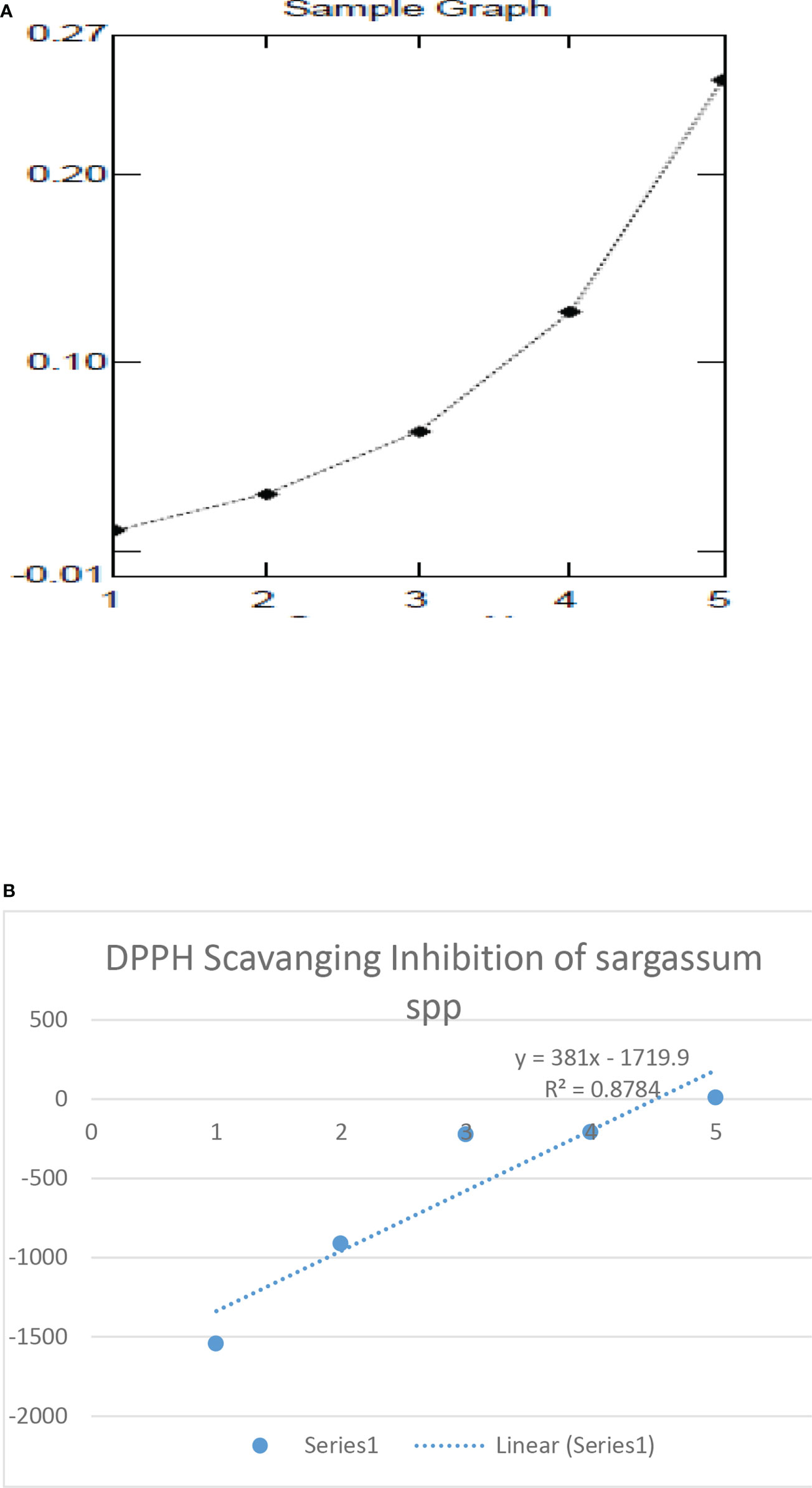
Figure 4 (A) Graph absorbance against concentration sargassum extract. (B) Inhibition % of with different concentration analyzed using DPPH radical scavenging method.
Antimicrobial activity
Antifungal activity
Antifungal activity results revealed that Sargassum sp. extract was tested at two fungal organism strains: Candida albicans (NCIM 3100) and Aspergillus niger (ATCC504) with a standard fungicide like Fluconazole. The result of the antifungal activity is Sargassum sp. shows the highest inhibition in Aspergillus niger as compared Candida albicans. We can observe in Table 4, and Figures 5, 6 that some reports similar to our investigation also reported Ulva lactuca (36 mm) had the highest antifungal activity against Aspergillus niger in methanol extract, followed by Sargassum tenerrimum (35 mm) at 200 µL. This Fluconazole, ketoconazole, and amphotericin B, three standard fungicides, had inhibition zones of 10, 17, and 18 mm against Aspergillus niger respectively.
Antibacterial activity
The result of antibacterial activity of aqueous extract of Sargassum sp. is at the concentration at 1mg/ml against different bacterial strains Staphylococcus aureus (NCIM2178), Bacillus subtilis (NCIM2063), Proteus mirabilis (NCIM2388), Escherichia coli (NCIM2065) they show inhibition zone Table 5: Antibacterial activity of Sargassum extract. The result of antibacterial activity is mentioned in Figure 6. Antibacterial plates of Sargassum extract. During this activity, we used as the control antibiotics Sterptomycin which can be observed in Table 5.
Discussion
Physiochemical analysis
The amount of mineral salt in seaweed is determined by the type, age, and state of hydrology. Where the habitat of seagrass is hydro-chemical. Sargassum crassifolium, Sargassum polycystum, and Sargassum echinocarpum grew on the Gunung Kidul coral shore in Yogyakarta, Indonesia. Ash content was reported as the ranges from 18.20 to 8.59% (Mushollaeni, 2011). The physicochemical properties of Sargassum wightii crude powder It had a moisture content of 12%. The total ash content was 34.83%, with 12.5%water soluble ash and 7.5% acid-insoluble ash. Alcohol solvent has the highest soluble extractive value (3.44%). The extractive value in water was 3.01%. Analytical data of Sargassum vulgare alginates have reported that in two different extracts, SVLV (S. vulgare low viscosity) and SVHV (Sargassum vulgare low viscosity), respectively 16 and 14% (Torres et al., 2007). The moisture content of sodium alginate powder derived from Sargassum sp. was reported to be 12.69 to1.24 percent (Kusumawati et al., 2018). Sargassum cristaefolium and Sargassum crassifolium had a water content of 89.34 percent and 88.56 percent, respectively. Species, harvest age, can influence water content differences in Sargassum, and environmental circumstances Sargassum crassifolium has a high ash content (41.52) and in Sargassum cristaefolium (41.28) (Dewinta et al., 2020). The three main kinds of photosynthetic pigments—phycobilins, carotenoids (including beta-carotene and xanthophylls), and chlorophylls (a, b, and c)—are significant to the existence of plant species (phycoerythrin and phycocyanin) (Nazarudin et al., 2020).
GCMS profile of Sargassum aqueous extract:
The existence of many volatile components such as normal hydrocarbon, alcohols, fatty acids, aliphatic compounds, benzene derivatives, aldehyde, and terpenoid was discovered using GC/MS analysis of the n-hexane soluble fraction of S. ilicifolium A total of fifty-one compounds were isolated and identified, with forty-six of them being discovered for the first time. According to the data, our extract has the highest quantity of hexadecanoic acid, followed by octadecanoic acid. However, hexadecanoic acid is a previously identified chemical from this source, but octadecenoic acid is a novel compound from Sargassum ilicifolium. Our findings revealed the presence of steroids in Sargassum ilicifolium, including spiro (1, 3-dioxolane)-2, 3′-(5′-androsten-16′-ol) and estra-1, 3, 5(10)-trien-17-ol. has been reported in previous study GC-MS analysis of n-hexane extract revealed that the largest quantity of hexadecanoic acid was detected, followed by cis-13- octadecenoic acid, hexanoic acid 2-ethyl-oxybis (2,1-ethanediyloxy-2,1-ethanediyl) ester, and 6-octadecenoic acid. Fatty acids related substances found in Sargassum fulvellum and S. thunbergii have anti-inflammatory properties because they are competitive inhibitors of cyclooxygenase and/or lipoxygenase, lowering prostaglandin and leukotriene synthesis (Hira et al., 2021). Another report similar to our result: The GC-MS analysis of Sargassum sp. hexane extract revealed sixteen chemical components. Out of those, the one with the fastest retention time in minutes was Pentriacontane, n-eicosane (25.68), Docosane, 11 decyl (24.95), Eicosane, n-eicosane (25.68), Eicosane, n-eicosane (25.68), Eicosane, n-eicosane (22.86) These antibacterial chemicals were made up of alkane, alkene, alkanol, and carboxylic acids. Antibacterial chemicals are thought to synergistically reduce bacterial growth (Firdaus et al., 2019). The GC-MS analysis of these seaweed samples’ methanolic extracts revealed the presence of 24 metabolites in S. ilicifolium and the identification of 27 metabolites in U. intestinalis and 22 compounds in H. macroloba. The major compounds identified were n-hexadecanoic acid (16.16%), 3,7,11,15-tetramethyl-2-hexadecen-1-ol (12.76%), stigmast-5-en-3-ol, (3β,24S)-(6.73%), 1,2-benzenedicarboxylic acid, mono(2-ethylhexyl) ester (5.48%), benzenepropanoic acid, 3,5-bis(1,1-dimethylethyl)-4-hydroxy-, methyl ester (4.97%), and phenol, 2,4-bis(1,1-dimethylethyl) - (4.23%). The metabolites in S. ilicifolium were identified as 1,2-benzenedicarboxylic acid, mono(2-ethylhexyl) ester (7.69%), benzenepropanoic acid, 3,5-bis(1,1-dimethylethyl)-4-hydroxy-, methyl ester (7.03%), phenol, 3,5-bis(1,1-dimethylethyl)- (6.54%), and 3,7,11,15-tetramethyl-2-hexadecen-1-ol (6.24%), hexadecanoic acid, and methyl ester (5.28%) (Nazarudin et al., 2020). 0ne of reports available Several species of Sargassum have been reported from the Yucatan peninsula coast. On the three most prevalent species, GC-MS tests were conducted to hunt for chemicals unique to each species. Depending on the solvent used, our study revealed various chemical components. Hexanoic acid, 2-ethyl, and epistephamiersine were discovered in S. hystrix, while benzyl benzoate and epistephamiersine were detected in S. buxifolium in the dichloromethane fraction. The hexane fraction of the latter species contained cholesta-4,6-dien-3-ol, (á)-, while S. fluitans contained 2,2-ethyldenebis(4,6- di-tert-butylphenol) and 2-pentadecanone, 6,10,14-trimethyl (Rosado-Espinosa et al., 2020).
Antioxidant activity
Antioxidant activity in marine algae is linked to the presence of bioactive substances such as vitamins and vitamin precursors, pigments, phenolics, phospholipids, peptides, terpenoids, and other antioxidative substances capable of scavenging free radicals generated during the scavenging of oxygen-containing compounds, metal-chelating ability, or peroxidation (Cox et al., 2010). It has been reported that because of its hypopigmented, anti-wrinkle, moisturizing, and antibacterial properties, free radical inhibition with natural antioxidants has become a popular therapeutic treatment for skin ageing. According to certain studies, the algal extract has potent free radical scavenging activities and can be used as a natural antioxidant in cosmetics (Arguelles et al., 2019). It has been reported that due to its hydrogen-donating characteristics, S. vulgare extract acts as an antioxidant. Furthermore, the antioxidative activity of the seaweed extract increases with concentration, with an EC50 value of 37.2 ± 0.015 μg Gallic acid equivalent (Arguelles, 2021). Sargassum is the most diversified genus among Iranian macroalgae, and studies have shown that its extract has antioxidant qualities. The Persian Gulf’s coastline waters include Sargassum boveanum, a natural and affordable source of the antioxidant chemical. Sargassum species contain significant levels of phenolic compounds such meroterpenoids, phlorotannins, and fucoxanthins, and numerous studies have noted the chemicals’ antioxidant benefits (Savaghebi et al., 2020). Seaweeds are currently acknowledged as prospective sources of several bioactive metabolites, which are attractive for prospection efforts in the search for new functional components and pharmacophores/drugs. In keeping with customer preferences for natural ingredients, seaweed antioxidants are a sustainable alternative to synthetic antioxidants and can be used as functional components in foods or cosmetics. In vitro research has typically focused on examining seaweed’s lipophilic components, such as carotenoids, certain polyphenols, and flavonoids with antioxidant activity. Antioxidant activity bioprospecting for Sargassum muticum species. The plant Sargassum muticum had the highest concentration of n-3 FA. Both seaweed extracts showed antioxidant activity at low doses, although S. modicum’s results were more encouraging. These results highlight the usefulness of both seaweeds as potential sources of bioactive and valuable chemicals, enhancing their nutritional and industrial potential. The bioactivity and unusual lipid composition of Sargassum muticum suggest that there may be a practical way to make use of this invasive seaweed, mainly when Sargassum blooms are prevalent (Santos et al., 2020). It was also observed that the scavenging capacity increased with fucoidan concentration (Seaweed, 2013). DPPH scavenging activity at different concentrations our result is similar to the yield from hot water extracts of S. ilicifolium (2.89-3.49%) and S. turbinaroides (6.00-7.36%) extracted at different temperatures (Artemisia et al., 2019).
Antimicrobial activity
The methanol extract was found to be the most potent fraction against both of the tested A. niger fungus in this study. However, all of the extracts examined had more substantial antifungal effects at higher concentrations than the conventional antifungals fluconazole, ketoconazole, and amphotericin (Barot et al., 2016). Another report on the Antifungal activity of 96% ethanol extracts of Sargassum crassifolium and Sargassum polycystum against Candida albicans growth revealed a wide range of inhibitory diameters. The inhibitory areas of Sargassum crassifolium and Sargassum polycystum extracts are 20.3 mm and 20 mm in diameter, respectively KOMALA and TRIASTINURMIATININGSIH (Yulianti, 2018). Streptomycin is an aminoglycoside antibiotic that was discovered in Streptomyces griseus bacterium. It is the first aminoglycoside antibiotic to be identified. Its primary application is in the treatment of aerobic gram-negative bacterial infections. Streptomycin has a wide range of antibacterial properties. Antibiotics are an excellent example of a commercially available antibacterial agent that helps the immune system fight and stop bacterial infections.
Along with this, we can confirm that strained P. mirabilis (NCIM2388) has the highest inhibition zone out of all these. Another investigation found that the antibacterial activity of S. ilicifolium extract against three strains of Staphylococcus identified in this study is stronger than that of other brown seaweed species (Arguelles, 2021). There is one report of inhibition zone of Sargassum sp hexane extract against S. aureus and E. coli occurs at a concentration of respectively 500, 1000, 1500 ppm, they show inhibition zone which is very less as compared with our result S.aureus (2.2, 4.2, and 6.2 mm) while for E.coli (1.6, 4.2and 4.2 mm) (Firdaus et al., 2019). The antibacterial characteristics of this seaweed demonstrate the presence of bioactive compounds in the extract with promising biological activity. It can also be utilized as a secondary source of energy—cosmetics with natural active component formulation (Arguelles, 2021).
Sargassum fluitans was used to extract alginate. Gliricidia sepium was used in the green synthesis to produce AgNPs. The AgNPs were examined using the UV-Vis and dynamic light scattering (DLS). Several fungal strains were used to examine the antifungal activity of AgNPs. Alginate concentrations of 2, 3, and 3%, as well as 0, 1, and 2 mg of AgNPs per mL of formulation, were used to create the films, along with glycerol as a plasticizer. Alginate and AgNPs concentrations were tested using a randomised experimental approach (Martinez-Molina et al., 2022).
Conclusion
In ancient times, brown seaweed served the purpose of food and helped treat various diseases. Overall analysis shows that brown algae are the most significant potential for human health nutrition, while pharmacological analysis is helpful for therapeutic application. In this, we generally discussed Sargassum sp., the nutritional profile, and physicochemical Parameters that can easily conclude Sargassum sp. is widely applicable in the part of diet or food as well as the part that fulfills human nutrition. While the Pharmacological potentials are represented by the Antioxidant and antimicrobial, it concludes that they can be applied to treating disease and enhance immunity.
Data availability statement
The original contributions presented in the study are included in the article/supplementary material. Further inquiries can be directed to the corresponding author.
Author contributions
MB, VCK, and GA designed the study and MB, ZA, AM, LW, and KW conducted the study with support from VC and GA; MF, ZA, AM, LW, MAT, MRAMZ, MM, AM, and KW performed the measurements, analysis the data and article preparation. All authors agreed for the submission of the article.
Acknowledgments
This study is part of the first author’s Ph. D research at the Department of Botany, Yashavantrao Chavan Institute of Science, Satara. The authors are thankful to Department of botany for everyone encouragement and support, for their technical assistance is gratefully acknowledged.
Conflict of interest
The authors declare that the research was conducted in the absence of any commercial or financial relationships that could be construed as a potential conflict of interest.
Publisher’s note
All claims expressed in this article are solely those of the authors and do not necessarily represent those of their affiliated organizations, or those of the publisher, the editors and the reviewers. Any product that may be evaluated in this article, or claim that may be made by its manufacturer, is not guaranteed or endorsed by the publisher.
References
Anastyuk S. D., Shevchenko N. M., Usoltseva R. V., Silchenko A. S., Zadorozhny P. A., Dmitrenok P. S., et al. (2017). Structural features and anticancer activity in vitro of fucoidan derivatives from brown alga saccharina cichorioides. Carbohydr. polymers 157, 1503–1510. doi: 10.1016/j.carbpol.2016.11.031
Aneja K. (2007). Experiments in microbiology, plant pathology and biotechnology (Delhi: New Age International).
Arguelles E. D. L. R. (2021). Evaluation of antioxidant capacity, tyrosinase inhibition, and antibacterial activities of brown seaweed, sargassum ilicifolium (Turner) c. agardh 1820 for cosmeceutical application. J. Fisheries Environ. 45, 64–77.
Arguelles E., Monsalud R. G., Sapin A. B. (2019). Chemical composition and in vitro antioxidant and antibacterial activities of sargassum vulgare c. agardh from lobo, batangas, Philippines. J. Int. Soc. Southeast Asian Agric. Sci. 25, 112–122.
Artemisia R., Nugroho A. K., Setyowati E. P., Martien R. (2019). The properties of brown marine algae sargassum turbinarioides and sargassum ilicifolium collected from yogyakarta, Indonesia. Indonesian J. Pharm. 30, 43. doi: 10.14499/indonesianjpharm30iss1pp43
Barot M., Kumar N., Kumar R. N. (2016). Bioactive compounds and antifungal activity of three different seaweed species ulva lactuca, sargassum tenerrimum and laurencia obtusa collected from okha coast, Western India. J. Coast. Life Med. 4, 284–289. doi: 10.12980/jclm.4.2016J5-185
Barwant M. M., Karande V. C. (2021). Review on nutritive value of brown seaweed & their health benefits. J. Maharaja Sayajirao Univ. Baroda ISSN 25, 0422.
Casas-Valdez M., Hernández-Contreras H., Marin-Alvarez A., Aguila-Ramirez R., Hernández-Guerrero C., Sanchez-Rodriguez I., et al. (2006). The seaweed sargassum (Sargassaceae) as tropical alternative for goats' feeding. Rev. Biología Trop. 54, 83–92.
Chanda S. (2014). Importance of pharmacognostic study of medicinal plants: An overview. J. pharmacognosy Phytochem. 2 (5), 69–73.
Choi Y. Y., Lee S. J., Kim H. S., Eom J. S., Kim D. H., Lee S. S. (2020a). The potential nutritive value of sargassum fulvellum as a feed ingredient for ruminants. Algal Res. 45, 101761. doi: 10.1016/j.algal.2019.101761
Choi Y. Y., Lee S. J., Lee Y. J., Kim H. S., Eom J. S., Kim S. C., et al. (2020b). New challenges for efficient usage of sargassum fusiforme for ruminant production. Sci. Rep. 10, 1–13. doi: 10.1038/s41598-020-76700-3
Cox R. M., Parker E. U., Cheney D. M., Liebl A. L., Martin L. B., Calsbeek R. (2010). Experimental evidence for physiological costs underlying the trade-off between reproduction and survival. Functional Ecology 24 (6), 1262–1269. doi: 10.1111/j.1365-2435.2010.01756.x
Dawczynski C., Schubert R., Jahreis G. (2007). Amino acids, fatty acids, and dietary fibre in edible seaweed products. Food Chem. 103, 891–899. doi: 10.1016/j.foodchem.2006.09.041
Debbarma J., Rao B M., Murthy L. N., Mathew S., Venkatheshwarlu G., Ravishankar C. (2016). Nutritional profiling of the edible seaweeds gracilaria edulis, ulva lactuca and sargassum sp. (RP0572). Ernakulam North P.O., Kochi: Central Marine Fisheries Research Institute (on behalf of Indian Council of Agricultural). doi: 10.21077/IJF.2016.63.3.60073-11
Dewinta A., Susetya I., Suriani M. (2020). Nutritional profile of sargassum sp. from pane island, tapanuli tengah as a component of functional food. J. Physics: Conf. Series: IOP Publishing 1542, 012040. doi: 10.1088/1742-6596/1542/1/012040
Firdaus M., Kartikaningsih H., Sulifah U. (2019). “Sargassum spp extract inhibits the growth of foodborne illness bacteria,” in AIP Conference Proceedings. AIP Publishing LLC 2202 (1), 020083. doi: 10.1063/1.5141696
Garg R. K., Kalra S., Mahadevan N., Shivali D. V. (2011). Pharmacognostic investigation of polygonum nepalense. Int. J. Recent Adv. Pharmaceut. Res. 1, 40–44.
Hira K., Farhat H., Sohail N., Ansari M., Ara J., Ehteshamul-Haque S. (2021). Hepatoprotective activity against acetaminophen-induced liver dysfunction and GC-MS profiling of a brown algae sargassum ilicifolium. Clin. Phytoscience 7, 1–11. doi: 10.1186/s40816-021-00274-4
Kusumawati R., Basmal J., Utomo B. B. (2018). Physicochemical characteristics of sodium alginate extracted from turbinaria sp. and sargassum sp. Squalen Bull. Mar. Fisheries Postharvest Biotechnol. 13, 79–84. doi: 10.15578/squalen.v13i2.297
Laihao L., Xianqing Y., Yanyan W., Peiji C. (1997). Analysis of nutritive composition in sargassum and its evaluation in nutriology. J. Ocean Univ. Qingdao 27, 319–325.
Lin P., Chen S., Liao M., Wang W. (2022). Physicochemical characterization of fucoidans from sargassum henslowianum c. agardh and their antithrombotic activity In vitro. Mar. Drugs 20 (5), 300. doi: 10.3390/md20050300
Liu J., Luthuli S., Wu Q., Wu M., Choi J.-I., Tong H. (2020). Pharmaceutical and nutraceutical potential applications of sargassum fulvellum. BioMed. Res. Int. 2020, 01–12. doi: 10.1155/2020/2417410
Macdonald-Wicks L. K., Wood L. G., Garg M. L. (2006). Methodology for the determination of biological antioxidant capacity in vitro: a review. J. Sci. Food Agric. 86, 2046–2056. doi: 10.1002/jsfa.2603
Martínez-Molina E. C., Freile-Pelegrín Y., Ovando-Chacón S. L., Gutiérrez-Miceli F. A., Ruiz-Cabrera M.Á., Grajales-Lagunes A., et al. (2022). Development and characterization of alginate-based edible film from sargassum fluitans incorporated with silver nanoparticles obtained by green synthesis. J. Food Measurement Characterization 16 (1), 126–136. doi: 10.1007/s11694-021-01156-6
Moon J.-K., Shibamoto T. (2009). Antioxidant assays for plant and food components. J. Agric. Food Chem. 57, 1655–1666. doi: 10.1021/jf803537k
Mushollaeni W. (2011). The physicochemical characteristics of sodium alginate from Indonesian brown seaweeds. Afr. J. Food Sci. 5, 349–352.
Nazarudin M. F., Isha A., Mastuki S. N., Ain N. M., Mohd Ikhsan N. F., Abidin A. Z., et al. (2020). Chemical composition and evaluation of the α-glucosidase inhibitory and cytotoxic properties of marine algae ulva intestinalis, halimeda macroloba, and sargassum ilicifolium. Evidence-Based Complementary Altern. Med. 2020, 2753945. doi: 10.1155/2020/2753945
Negara B. F. S. P., Sohn J. H., Kim J. S., Choi J. S. (2021). Antifungal and larvicidal activities of phlorotannins from brown seaweeds. Mar. Drugs 19 (4), 223. doi: 10.3390/md19040223
Pharmacopoeia I. (1996). (Government of india. ministry of health & family welfare Vol. VoL. I & II (Delhi: The controller of publications).
Ranjani Devi M., Premraj Loganathan A. P., Jmv K. (2018). Pharmacognostical and phytochemical analysis of sargassum cinereum (Turner) c. agardh. J. pharmacognosy Phytochem. 7, 2233–2238.
Rhein-Knudsen N., Ale M. T., Ajalloueian F., Meyer A. S. (2017). Characterization of alginates from ghanaian brown seaweeds: Sargassum spp. and padina spp. Food Hydrocolloids 71, 236–244. doi: 10.1016/j.foodhyd.2017.05.016
Rosado-Espinosa L. A., Freile-Pelegrín Y., Hernández-Nuñez E., Robledo D. (2020). A comparative study of sargassum species from the Yucatan peninsula coast: morphological and chemical characterisation. Phycologia 59 (3), 261–271. doi: 10.1080/00318884.2020.1738194
Santos F., Monteiro J. P., Duarte D., Melo T., Lopes D., da Costa E., et al. (2020). Unraveling the lipidome and antioxidant activity of native bifurcaria bifurcata and invasive sargassum muticum seaweeds: A lipid perspective on how systemic intrusion may present an opportunity. Antioxidants 9 (7), 642. doi: 10.3390/antiox9070642
Savaghebi D., Barzegar M., Mozafari M. R. (2020). Manufacturing of nanoliposomal extract from sargassum boveanum algae and investigating its release behavior and antioxidant activity. Food Sci. Nutr. 8 (1), 299–310. doi: 10.1002/fsn3.1306
Seaweed I. B. (2013). Isolation and evaluation of antioxidant and antibacterial activities of fucoidan rich extract (Fre) from Indian brown seaweed, sargassum wightii d. Eds. Prabu L., Sahu N. P., Pal A. K., Narendra A. (Versova: Division of Fish Nutrition, Biochemistry and Physiology, Central Institute of Fisheries Education).
Serrano A. E. Jr., Declarador R. S., Tumbokon B. L. M. (2015). Proximate composition and apparent digestibility coefficient of sargassum spp. meal in the Nile tilapia, oreochromis niloticus. Anim. Biol. Anim. Husbandry 7, 159–168.
Srinivasan K. (1969). Phycologia Indica:(Icones of Indian marine algae) (Calcutta: Botanical Survey of India).
Torres M. R., Sousa A. P., Silva Filho E. A., Melo D. F., Feitosa J. P., De Paula R. C., et al. (2007). Extraction and physicochemical characterization of sargassum vulgare alginate from Brazil. Carbohydr. Res. 342, 2067–2074. doi: 10.1016/j.carres.2007.05.022
Xiao H., Chen C., Li C., Huang Q., Fu X. (2019). Physicochemical characterization, antioxidant and hypoglycemic activities of selenized polysaccharides from sargassum pallidum. Int. J. Biol. macromolecules 132, 308–315. doi: 10.1016/j.ijbiomac.2019.03.138
Yulianti R. (2018). Antifungal activity sargassum crassifolium and sargassum polycyctum against candida albicans oom komala, triastinurmiatiningsih. Availbale at: https://www.semanticscholar.org/paper/ANTIFUNGAL-ACTIVITY-SARGASSUM-CRASSIFOLIUM-AND-OOM-Yulianti/9e5b25d92f41bdb8641fa3ce4e551cabd0cc9b8e.
Keywords: brown algae, pharmacological study, Western Coast of Maharashtra, biological study, biochemical profile, sargassum sp
Citation: Abdi G, Karande VC, Mohammed A, Abbasi Tarighat M, Wen Goh K, Abdul Kari Z, Seong Wei L, Ahmad Mohd Zain MR, Mohammadi M, Ee Lee G and Barwant MM (2022) Pharmacological potential of Sargassum sp. of west coast of Maharashtra Kunkeshwar, India. Front. Mar. Sci. 9:1011218. doi: 10.3389/fmars.2022.1011218
Received: 22 August 2022; Accepted: 03 November 2022;
Published: 16 December 2022.
Edited by:
Won-Kyo Jung, Pukyong National University, Republic of KoreaReviewed by:
Fazlurrahman Khan, Pukyong National University, Republic of KoreaMeivelu Moovendhan, Sathyabama Institute of Science and Technology, India
Copyright © 2022 Abdi, Karande, Mohammed, Abbasi Tarighat, Wen Goh, Abdul Kari, Seong Wei, Ahmad Mohd Zain, Mohammadi, Ee Lee and Barwant. This is an open-access article distributed under the terms of the Creative Commons Attribution License (CC BY). The use, distribution or reproduction in other forums is permitted, provided the original author(s) and the copyright owner(s) are credited and that the original publication in this journal is cited, in accordance with accepted academic practice. No use, distribution or reproduction is permitted which does not comply with these terms.
*Correspondence: Khang Wen Goh, a2hhbmd3ZW4uZ29oQG5ld2ludGkuZWR1Lm15; Muhammad Rajaei Ahmad Mohd Zain, cmFqYWVpQHVzbS5teQ==; Mukul M. Barwant, bXVrdWxiYXJ3YW50OTdAZ21haWwuY29t
 Gholamreza Abdi
Gholamreza Abdi Vanita Chandrashekhar Karande2
Vanita Chandrashekhar Karande2 Zulhisyam Abdul Kari
Zulhisyam Abdul Kari Lee Seong Wei
Lee Seong Wei Mukul M. Barwant
Mukul M. Barwant